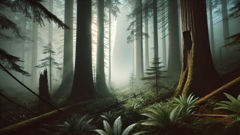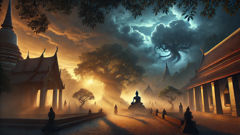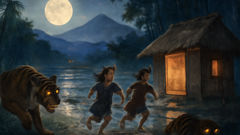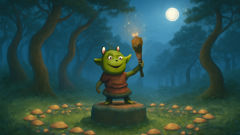Introduction
In the vast, rugged expanse of Canada’s Pacific Northwest, stories have always lingered like mist in the towering forests. Here, ancient cedars reach for the sky, their bark etched with age-old secrets, and the dense undergrowth muffles footsteps and whispers. For centuries, the people living at the edge of these wildlands—Indigenous families whose roots go deeper than the oldest tree rings, fur trappers with stories traded around campfires, and modern explorers hungry for wonder—have all spoken of a presence just out of sight. They call it Sasq’ets, or Sasquatch: a being of shadow and substance, large and shaggy, both part of the land and apart from it. Some say it’s a spirit, a guardian watching over the balance of the wild. Others argue it’s a flesh-and-blood creature, a relic of a forgotten time, haunting the endless green. The legend is woven into the place itself, as persistent as moss on stone, as haunting as the hoot of an owl on a cold, starless night.
As the world beyond the treeline rushes toward technology and certainty, the forests hold their mysteries close. Skeptics bring equipment and theories, searching for footprints or blurry photographs, while local elders quietly recall tales from before the first railway snaked its way west. There’s something magnetic about the legend, drawing in the curious and the hopeful. It’s not just a question of whether the Sasquatch exists—it’s what the possibility says about the wildness that remains in our world, about what we’re willing to believe. In this story, three lives will intersect: a wildlife photographer with a heart full of longing for the untamed, a scientist whose faith lies in reason alone, and an elder who knows that some truths are deeper than proof. Their journey through the heart of British Columbia’s rain-soaked forests will test not only their nerves but also their understanding of nature, myth, and each other. Amid the emerald hush and tangled roots, they’ll learn that legends are not simply stories left behind—they are paths leading forward, deeper into the unknown.
The Photographer’s Calling
Eliot Carter had spent most of his thirty-two years in pursuit of things others deemed impossible to capture. The first time he heard the word Sasquatch, he was barely seven, listening wide-eyed as his grandfather, a Haida fisherman, told stories in the flicker of firelight. The tales had sunk into Eliot’s bones, growing alongside him through childhood and adolescence, even as he swapped wooden toys for cameras and firelight for computer screens. He became a wildlife photographer, renowned for his patience and uncanny ability to melt into the landscape. His work graced glossy magazines and conservation posters, but the image he most wanted—the one he dreamt about on restless nights—remained out of reach: the real Sasquatch.
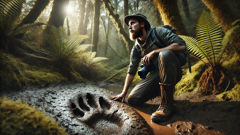
That spring, Eliot returned to the forest that bordered his grandfather’s old fishing cabin, carrying a battered backpack and an arsenal of cameras. The air was wet with recent rain, smelling of cedar, loam, and something ancient. Every step onto the moss felt like crossing a threshold into another world. He set up camp by the banks of a nameless stream. His first nights were spent listening—to the wind’s sigh, to the soft snap of branches, to the distant calls of owls. He’d learned long ago that patience was everything. The forest had to forget you were there.
On his fourth evening, Eliot found a track: five toes, nearly twice the length of his boot, pressed into mud near the water. He crouched, heart pounding, snapping photo after photo. He measured the depth, the spread—convincing himself it was a bear’s mark. But as dusk settled and the forest went quiet, doubt crept in. The tracks went on, vanishing into an impassable thicket. He waited until the moon rose, camera poised for any sign of movement. That night, he heard a low, rumbling call that vibrated through his ribcage—a sound no wolf or bear could make.
The next morning, Eliot’s trail camera had been knocked askew. On its memory card: a blurry shape, towering and upright, just at the edge of the frame. It could have been a trick of the light. But it felt like an invitation—a reminder that some things stay hidden only because they choose to. Eliot packed his gear, determined to go deeper.
Two days later, he crossed paths with Dr. Evelyn Singh, a zoologist from the University of British Columbia. She was mapping animal populations for a grant, and unlike Eliot, she believed only in what could be cataloged and classified. Her tent was pitched at the edge of a sunlit clearing, its canvas splattered with mud. When Eliot shared his story, she gave him a polite but skeptical smile. “You probably saw a bear. Or someone playing a prank,” she said, her voice clipped. Still, she was intrigued enough to join him on his search.
Eliot and Evelyn spent days tracing rumors—finding snapped branches high above their heads, strange hair samples caught on brambles, and more prints. Evelyn catalogued everything, cross-referencing with known species. Yet, she couldn’t explain the oddities: the way birds fell silent in certain groves, the tangled nests built from woven bark high in the trees, the deep, echoing howls at dusk. Their days grew longer and stranger. Eliot felt as if the forest itself was guiding them somewhere. They began to notice subtle signs—stone stacks by a creek, sticks arranged in patterns too deliberate to be chance.
The Scientist’s Dilemma
Evelyn Singh’s world was built on certainty. She had grown up in Vancouver’s city sprawl, where the only wild things were crows and the occasional raccoon raiding garbage bins. Her father was a botanist; her mother, a mathematician. Numbers and data had been her comfort, her armor against the unpredictable. But after a decade researching North America’s elusive creatures, Evelyn had learned that nature had its own rules. She’d seen mountain lions vanish like ghosts, river otters that left no trace but ripples in the water. Yet nothing challenged her beliefs like the rumors of Sasquatch. She joined Eliot not because she believed, but because she wanted to disprove.
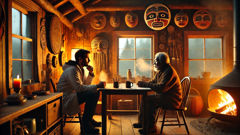
As they ventured deeper into the woods, Evelyn found her skepticism tested. She’d collected hairs tangled in branches that didn’t match any known animal, droppings filled with crushed berries and roots, and intricate woven mats of grass laid beneath massive conifers. The forest was alive with evidence that something—or someone—was moving just out of sight. Yet whenever she tried to rationalize, she found herself confronted with gaps. Bears didn’t build nests. No known primate roamed these woods. She ran DNA tests on samples in her field kit, but sometimes the results came back as “inconclusive” or “unknown primate,” the machine blinking back at her with infuriating ambiguity.
At night, Evelyn and Eliot would sit around a small fire. Eliot would share stories from his grandfather: of hairy figures glimpsed in moonlight, of offerings left on cedar stumps, of footprints appearing overnight on snow. Evelyn listened, sometimes rolling her eyes, but increasingly she felt drawn in. One evening, she found herself recounting a strange childhood memory: a summer hike where she’d heard something moving in the underbrush, a shape she’d glimpsed out of the corner of her eye. She’d always dismissed it as a deer or her imagination, but now she wondered.
After a week, Evelyn suggested visiting the local First Nations village. Eliot agreed, recalling his grandfather’s friendship with an elder named Agnes Talltree. Agnes was nearly ninety but sharp as winter air. She welcomed them with warm bannock and strong tea, her home filled with carved masks and woven baskets. When they asked about Sasquatch, she grew serious. “You’re not the first to look for what should not be seen,” she said. “Sasq’ets is not just an animal. It’s a part of these woods—a teacher. It comes when the balance is off.”
Agnes explained that in her people’s stories, Sasquatch appeared during times of change or trouble. It was both warning and guardian—a reminder that humans were guests in this land. She told them where to look for signs: twisted trees, sudden silences, gifts left in hidden places. “If you want answers, listen with more than your ears,” she advised. As they left, Evelyn felt both grounded and unsettled. Science didn’t have a protocol for listening with your heart.
The Elder’s Wisdom
Agnes Talltree’s memory was long and clear. She remembered a time before power lines and asphalt roads, when her people moved with the salmon runs and marked the seasons by the blooming of wildflowers. Her stories were as much a part of the forest as the roots beneath the soil. For Agnes, Sasquatch was not merely a legend to frighten children or amuse tourists. It was a living presence, woven into dreams and warnings, a bridge between worlds.
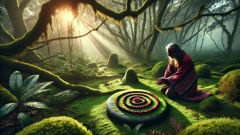
After Eliot and Evelyn’s visit, Agnes spent a night in quiet reflection. She lit cedar incense and sang old songs, inviting guidance from her ancestors. In her dreams, she saw the forest darken, rivers running too fast, birds scattering from the trees. Sasquatch stood at the edge of a clearing, watching her with eyes that reflected starlight. She woke before dawn, certain that something was stirring in the woods—something that needed to be understood, not hunted.
The next morning, Agnes gathered her walking stick and set out toward the old growth forest. She followed a path known only to her family, marked by subtle signs: stones stacked like cairns, a feather woven into a low branch, a cedar stump shaped like a heart. Agnes walked slowly, listening for more than sounds. The air felt charged with anticipation.
As she reached a mossy glade, she found a gift—berries arranged in a perfect spiral atop a flat stone. Agnes knelt, offering a quiet prayer. She felt the presence nearby: not threatening, but watchful. She remembered her grandfather’s teachings: “Sasq’ets comes when people forget to respect the land.” She wondered if all the strangers now combing the woods with cameras and drones had disturbed something sacred.
Returning home, Agnes decided to help Eliot and Evelyn in their search—but on her terms. She invited them to a salmon feast with her family, sharing not just food but songs and teachings about living with humility among the wild things. She explained the importance of reciprocity: “You don’t take without giving back. That’s how you find peace here.”
Under Agnes’s guidance, Eliot and Evelyn learned to move differently through the forest. They left small gifts—carved shells, sweetgrass—at the places where they found signs. They stopped speaking loudly or rushing; instead, they listened to the wind and watched the patterns of birds overhead. Gradually, the forest seemed to accept them. The footprints became clearer. The woven mats more intricate. One evening, as dusk fell and the world turned blue and gold, they saw a shadow move between the trees: impossibly tall, covered in dark hair, gliding without sound. It paused to look back at them before vanishing deeper into the wilderness.
Conclusion
As summer deepened and green gave way to gold, Eliot, Evelyn, and Agnes understood they had become part of something larger than any single encounter or photograph. Eliot’s camera now held images that hinted rather than proved—a broad shadow here, a huge handprint pressed into tree bark there. Evelyn’s field notes brimmed with mysteries science could not solve but could not dismiss either. For Agnes, the greatest reward was seeing the outsiders learn respect for land and legend alike. The Sasquatch remained elusive: not a beast to be caught or catalogued, but a symbol of what endures when mystery and reverence outlast explanation.
They returned to their separate worlds changed—Eliot more patient, Evelyn more open, Agnes reassured that the old ways still had meaning. The forest continued to hum with secrets, its shadows long and inviting. And somewhere between root and sky, the Sasquatch watched and waited, neither lost nor found, but forever a guardian of Canada’s wild heart.

